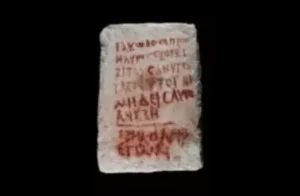A convert to Judaism warned away tomb raiders by vowing to curse anybody who would dare to open his grave.
An ominous and bloody-looking burial inscription warning people to stay away and let the deceased rest in peace was found in an ancient cave tomb in Beit She’arim.

The ancient curse
Written in a red paint, the inscription reads: “Jacob the Convert vows to curse anybody who would open this grave, so nobody will open it. He was 60.” It was apparently meant to keep grave robbers away.
The full text and the story of its discovery were presented at the Northern Conference, held jointly on June 1, 2022 by the University of Haifa and the northern region of the Israel Antiquities Authority (IAA).
The last three words of the curse were written in a different script and the researchers believe that they may were written after his death possibly by relatives.
Another small inscription, also painted in red, was on the limestone wall near a burial lodge, and simply said the name “Judah,” who archaeologists believe was the owner of the tomb. The larger inscription, written in red on a stone slab leaning against the opening of the same alcove, consisted of the eight lines warning people away from Jacob the Convert’s grave.
First inscription on deceased convert
The Greek-language curse inscription, from around the year 1800 CE, is the first burial inscription to be found in the Beit She’arim burial caves in 65 years. It is also the first inscription discovered which specifically mentions that a deceased person had been a convert.
Researchers said that inscriptions attesting to converts are not common, and those that have been previously uncovered are mostly from the Second Temple period or the Early Roman period, times when Judaism was the dominant identity in Judea.
“The present find is one of the few mentioning a convert from the Late Roman Period.”
Researchers of Jacob’s curse inscription
“The inscription is from the Late Roman or Early Byzantine period, when Christianity is gaining strength. And yet, we find evidence that there are still people who choose to join the Jewish people, “said Prof. Adi Erlich of the Zinman Institute of Archeology and Haifa University’s School of Archeology, who is leading the excavations at Beit She’arim.
Christianity began to take root during the Late Roman Period, in the 3rd and 4th centuries CE and later became the dominant religion in the Roman Empire.
Beit She’arim site
Beit She’arim, located in the Lower Galilee, was a central Jewish settlement during the Mishnah and Talmudic periods, in the 2nd to 5th centuries CE. After the destruction of Jerusalem in 70 CE the Jewish Sanhedrin Council moved there and it became an important center of Jewish learning and culture. The most famous part of the settlement is its cemetery which was excavated some 80 years ago. Burial inscriptions in various languages, especially in Greek which was the main spoken language at the time, have been found in the cemetery. Among the Jewish sages buried in the city’s cemetery is Rabbi Yehuda Hanasi, the second-century rabbi and chief redactor and editor of the Mishnah who was a key leader of the Jewish community during the Roman occupation of Judea.
Beit She’arim is now a national park and the cemetery was recognized as a World Heritage Site by the UN several years ago.
Though the Beit She’arim burial caves were already well-known, two inscriptions were discovered by chance in a new burial cave a year ago by Jonathan Orlin, head of conservation in the north region of the Israel Nature and Parks Authority.
The researchers said the new inscription, which has been handed over to the IAA for preservation, provides important information about life in the Galilee during that period, which became the center of Jewish settlement after the destruction of Judah in the Bar Kochba revolt in 135 CE.
